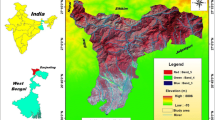Abstract
No method exists to increase the efficiency of controlling projects and reclamation of disturbed lands and avoid investment wasting, considering different criteria and alternatives and presenting optimal alternatives based on systematic and group perspectives in combating desertification. Recent proposed alternatives are usually non-systematic and non-comprehensive according to a scientific view. There is no record of application of systematic models such as multiple attribute decision-making in combating desertification. Therefore, in the present research, a fuzzy analytical hierarchy process (FAHP) method has been used to offer optimal alternatives challenging desertification. In the present study, the opinions of experts about alternatives and criteria have been assessed using the Delphi method and pairwise comparison. Then, the final priorities of the alternatives were obtained by a fuzzy decision matrix and the FAHP model. The model’s ability in offering alternatives to combat desertification was assessed in the Khezr Abad region, Yazd province. Based on the obtained results, the alternative of groundwater harvesting modification with weighted average of 93 % was determined as the optimum alternative in the study area; other alternatives had no effective effect in control of desertification.



Similar content being viewed by others
Notes
An optimal US industrial target system.
An isolated hill, knob, ridge, outcrop or small mountain.
An erg (also sand sea or dune sea, or sand sheet if it lacks dunes) is a broad, flat area of desert covered with wind-swept sand.
A desert surface covered with closely packed, interlocking angular or rounded rock fragments of pebble and cobble size.
The study area is a part of this basin.
Also known as an ‘alkali flat’ or ‘sabkha’, a desert basin with no outlet which periodically fills with water to form a temporary lake.
References
Asgharpour MJ (1992) Multiple criteria decision making. University of Tehran, Tehran, p 397
Azar A, Faraj H (2003) Knowledge of fuzzy management. Tarbyat Modares University, Tehran
Azar A, Rajabzadeh A (2002) Applied decision making, 1st edn. Negahe Danesh, Tehran, p 185
Bergamp Ger (1995) A hierarchical approach for desertification assessment. Environ Monit Assess 37:59–78
Buyukozkan G, Feyzioglu O (2004) A fuzzy-logic-based decision making approach for new product development. Int J Prod Econ 90:27–45
Cebeci U (2009) Fuzzy AHP-based decision support system for selecting ERP system in textile industry by using balanced scorecard. Expert Syst Appl 36:8900–8909
Chang DY (1996) Application of the extent analysis method on fuzzy AHP. Eur J Oper Res 95(3):649–655
Chutima P, Suwanfuji P (1998) Fuzzy analytical hierarchy process part routing in FMS. Thammasat Int J Sci Technol 3(2):29–74
Dagdeviren M, Yuksel I (2008) Developing a analytical hierarchy process (AHP) model for behavior-based management. Inf Sci 178:1717–1733
Dagdeviren M, Yavuz S, Kilinc N (2009) Weapon selection using the AHP and TOPSIS methods under fuzzy environment. Expert Syst Appl 36:8143–8151
Dalkey N, Helmer O (1963) An experimental application of the Delphi method to the use of experts. Manag Sci 9(3):458–467
Ghodsi Pour SH (2002) Analytical hierarchy process (AHP). Amirkabir University, Tehran
Gordon TJ (1994) The Delphi method. American Council for the United, Washington, DC
Kazemi Nejad A (1996) The study of sand dune movement. M.Sc. thesis, University of Tehran
Kong F, Liu H (2005) Applying fuzzy analytical hierarchy process to evaluate success factors of e-commerce. Int J Inf Syst Sci 1(3–4):406–412
Laarhoven V, Pedrycz W (1983) A fuzzy extension of Saaty′s priority theory. Fuzzy Sets Syst 11(3):229–241
Linstone HA, Turoff M (eds) (1975) The Delphi method: techniques and applications. Reading, MA: Addison-Wesley Publishing Company
Meixner O (2009) Fuzzy AHP group decision analysis and its application for the evaluation of energy sources. In: Proceedings of the 10th international symposium on the analytic hierarchy/network process, Pittsburtgh/PA, USA, Nations University
Saaty TL (1980) The analytic hierarchy process. McGraw-Hill International, New York
Saaty TL (1995) Decision making for leaders. The analytic hierarchy process for decisions in a complex Word.1995.1996 ed. completely revised. RWS Publications, Pittsburgh
Sadeghi Ravesh MH (2008) The research of desertification effective factors in environmental destroy (case study: Khezr Abad Zone, Environmental Management thesis, Islamic Azad University, 395
Sadeghi Ravesh MH, Ahmadi H, Zehtabian GH, Tahmores M (2010) Application of analytical hierarchy process (AHP) in assessment of de-desertification alternatives, case study: Khezrabad region, Yazd province. Marta Biaban J 17(1):35–50
Schneier-Madanes G, Marie-Françoise C (2010a) Water and sustainability in arid regions. In: Ahmadi H, Nazari Samani AA, Malakian A (eds) The Qanat: a living history in Iran. Springer, Berlin, pp 125–139
Schneier-Madanes G, Marie-Françoise C (2010b) Water and sustainability in arid regions. In: Zehtabian GH, Khosravi H, Ghodsi M (eds) High demand in a land of water scarcity: Iran. Springer, Berlin, pp 75–87
Somerville JA (2007) Critical factors affecting the meaningful assessment of student learning outcomes: a Delphi study of the opinions of community college personnel. Unpublished doctoral dissertation, Oregon State University, Corvallis, OR
Sredjevic B, Medeiros YDP (2008) Fuzzy AHP assessment of water management plans. Water Resour Manag 22:877–894
Sung WC (2001) Application of Delphi method, a qualitative and quantitative analysis, to the healthcare management. J Healthc Manag 2(2):11–20
Zare A, Ahmadi Naseri SM (2008) Presentation of sustainability indicators with using of fuzzy AHP sensitivity analysis. In: Fuzzy and intelligent systems conference, Ferdosi University, Mashhad
Zhu KJ, Jing Y, Chang DY (1999) Theory and Methodology: A discussion on extent analysis method and applications of fuzzy AHP. Eur J Oper Res 116:450–456
Author information
Authors and Affiliations
Corresponding author
Rights and permissions
About this article
Cite this article
Sadeghravesh, M.H., Khosravi, H. & Ghasemian, S. Application of fuzzy analytical hierarchy process for assessment of combating-desertification alternatives in central Iran. Nat Hazards 75, 653–667 (2015). https://doi.org/10.1007/s11069-014-1345-7
Received:
Accepted:
Published:
Issue Date:
DOI: https://doi.org/10.1007/s11069-014-1345-7




